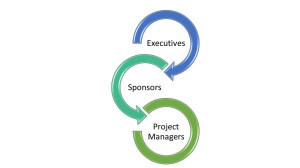The following is an extract from my new book ‘How to get Fired at the C-Level: Why mismanaging change is the biggest risk of all’ in association with my friends at Tailwind Project Solutions – previous extracts followed a series of 5 Challenges that I think every organisation should consider, and consider very carefully – and now we will look at the 5 tests of control:
Another quick test of control is the ‘Executive board to Sponsor to Project Manager’ relationship or the ‘ESP’ connection test.
Let’s start with the simplest form of this test by asking ‘Is there one?’.
Does the executive team interact with project sponsors on a regular basis, perhaps are they even the executive sponsors themselves? And do the sponsors interact and engage on a regular, bi-directional manner with the project managers?
Come up with a ’No’ at any of these connections and you have trouble ahead. You do need all three and you do need them connected and communicating.
If you don’t declare a complete and utter ‘No’ then the next step of the ‘ESP’ test is to consider any weak points in this ‘Executive board to Sponsor to Project Manager’ relationship. Here we can go back to the question of do the executives understand change (and projects), and/or do the change sponsors understand what it means to be such a sponsor, and how to go about being and effective sponsor, before arriving at the project management community and asking they know what they are doing, do they have experience and are they supported in skills and tools and method?
Such a consideration will allow another perspective on the robustness of your entire change management structure and to focus where there is a need.
One point here. If there is a problem at say the ‘E to S’ connection and also at the ‘S to P’ connection, then the priority has to be to focus and fix the ‘E to S’ problem first as the higher the issue the bigger the issue is in my personal experience.
TAKE THE TEST: Consider each level on the ESP connection and evaluate the change leadership maturity at each level – then assess the strength of connection at each of those touch points, ‘E to S’ and ‘S to P’.
Tailwind Project Solutions was formed in 2014 to provide a bespoke approach to project leadership development. Owned by Director & CEO Alex Marson, the organisation works with large FTSE 250 clients including some of the biggest companies in the world in the Asset Management, Professional Services, Software, Automotive, Finance and Pharmaceutical industry. The company has a team of world-class experts who provide a bespoke approach to the challenges that our clients have, and the company was formed because of a gap in the market for expertise which truly gets to the heart of the issues clients are facing – providing a robust, expert solution to change the way that companies run their projects.
At the time, the market was becoming flooded with training companies, providing a ‘sheep dip’ approach to project management, and the consensus was that This didn’t solve the real challenges that businesses and individuals are experiencing in this ever-increasing complex world of project management. The vision was to hand-pick and work with the very best consultants, trainers and coaches worldwide so that Tailwind could make a difference to their clients, to sit down with them, understand their pain points, what makes them tick, and what is driving their need for support.
These challenges being raised time and time again are in the project leadership space, from communication issues, not understanding stakeholder requirements or having the confidence to “push back”, lack of sponsorship support, working across different cultures, languages, levels of capability and complexity. We expect more from our project managers – we expect them to inspire, lead teams and be more confident.
Tailwind’s experience is vast, from providing interim resources in the project and programme management space, supporting the recruitment process, experiential workshops, coaching – from project managers through to executives, providing keynote speakers, implementing PPM Academies, PM Healthchecks and Leadership development. The approach is created often uniquely – to solve the real challenges of each of their individual clients.



